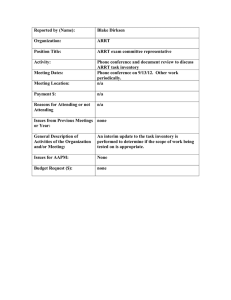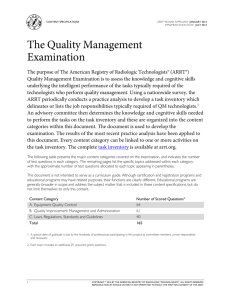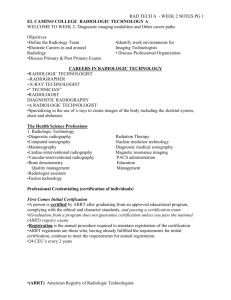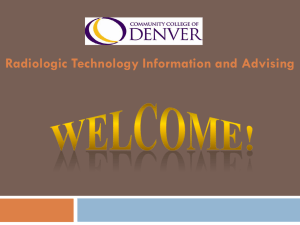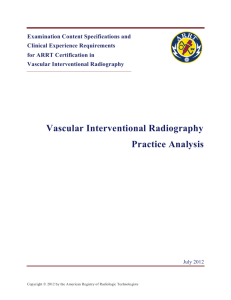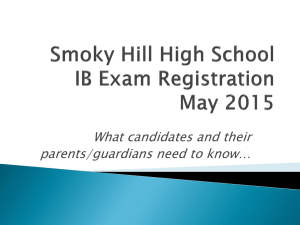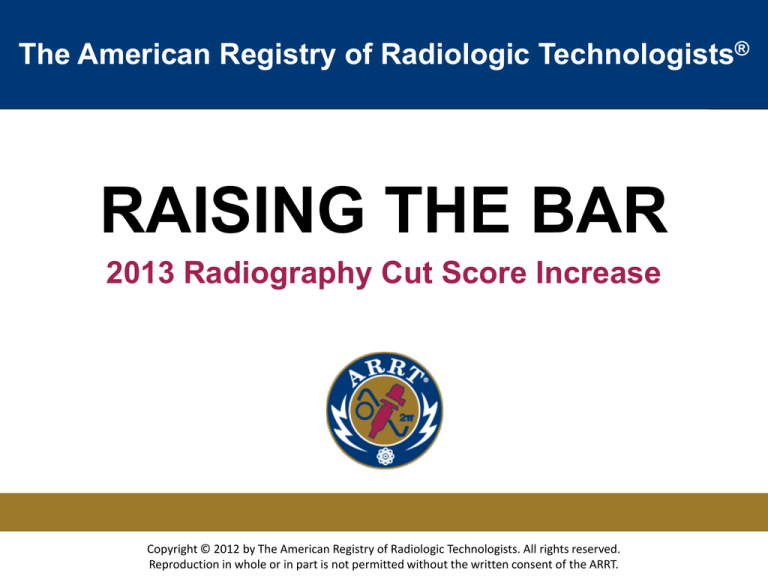
The American Registry of Radiologic Technologists®
RAISING THE BAR
2013 Radiography Cut Score Increase
Copyright © 2012 by The American Registry of Radiologic Technologists. All rights reserved.
Reproduction in whole or in part is not permitted without the written consent of the ARRT.
What’s New?
ARRT is increasing the Radiography exam
cut score, effective January 1, 2013
• Cut score establishes passing standard: achieving or surpassing
the cut score determines passing
• Periodic standard-setting exercise determines whether passing standards
continue to reflect appropriate expectations for professional performance
• Expectations for professional performance at entry level change over
time: what was good enough at one point in time may no longer be good
enough today
• Increasing professional expectations lead to increased cut score
What’s Not New?
The cut score changes, but other
certification requirements remain the same
• ARRT Equation for Excellence establishes certification criteria in
education, ethics and examination
• Educational requirements remain unchanged: successful
completion of a formal education program that is accredited by
an ARRT-accepted mechanism
• Ethics requirements remain unchanged: compliance with
minimally acceptable professional conduct
Exactly what is changing?
Candidates must correctly answer a
few more questions in order to pass
• Unchanged — number of scored questions is still 200
• Unchanged — difficulty level of questions is the same
• Unchanged — scaled score of 75 remains the passing standard
• Changed — beginning January 1, examinees have to correctly answer
a few more questions in order to pass
• A few? On a typical exam form, that number is six
How’s a cut score determined?
Periodic review to ensure that standards
reflect professional expectations
• Psychometricians lead Performance Standard Advisory committee
through standard-setting process by reviewing each question from a
representative exam form
• Committee — through multiple rounds — rates the percentage of
borderline-proficiency candidates who would answer correctly
• ARRT compiles data on recent exam performance and presents it
to the committee
• Resulting information is presented to Board of Trustees, which may
then adopt revised cut score
Who’s on the Committee?
Wide spectrum of subject-matter experts
and balance of perspectives
• Practicing Registered Technologists with Radiography credential
• Radiology managers
• Radiography educators
• Radiologist
• Medical physicist
...Committee meeting guided by an ARRT psychometrician
What’s a psychometrician?
ARRT staff psychometricians are Ph.D.
educated and professionally experienced
• Psychometrics is the field of study concerned with the theory and
technique of psychological measurement
• Includes the measurement of knowledge, abilities, attitudes,
personality traits, and educational measurement
• The profession is primarily concerned with the construction and
validation of measurement instruments such as questionnaires, tests,
and personality assessments
How are expectations defined?
Every six years, ARRT does comprehensive
practice analyses for primary exams
• Practice analysis — also called job analysis — is the systematic study
of a profession to describe the job responsibilities of those employed at
entry level in the profession
• Important for professions that continually evolve due to advances
in technology
• ARRT psychometricians last conducted a radiography practice analysis
in the 2009-2011 time frame
• Led to updated task inventory and content specifications to reflect
current practice
Cut score vs. scaled score?
The changed cut score is raising the bar,
but is still reported as a scaled score of 75
• Each candidate’s individual performance against the cut score is
translated into a scaled score
• Scaled scores maintain the standard across different forms of the exam
and the passage of time, so all candidates are rated on the same scale
• Like transforming a temperature from Fahrenheit to Celsius, the scale
used to report the temperature doesn’t affect the underlying physical
property, just how it’s communicated
How will this affect pass rates?
Only those at or near the former standard
would be at risk under the new standard
• Candidates who previously passed with scaled scores of 75 or 76
would not have passed under the new standard
• Candidates with scaled scores of 77 and above would have passed
under the new standard
• Candidates who scored outside these ranges would experience no
change in passing prospects
What’s the bottom line?
Everyone benefits when the bar is raised
for high standards of patient care
• Successful candidates can be confident that they have the knowledge
required to be effective in the workplace
• Educators who prepare those candidates can be more confident
that their graduates will be better prepared to provide patient care
• Administrators and supervisors in the workplace can have increased
faith in the qualifications of the entry-level radiographers that they hire
• Most importantly, the public can be assured that a highly qualified
professional is performing their imaging studies
Where can I get more info?
Call ARRT’s Initial Certification Department
at (651) 687-0048, ext. 8560 or visit
www.arrt.org

